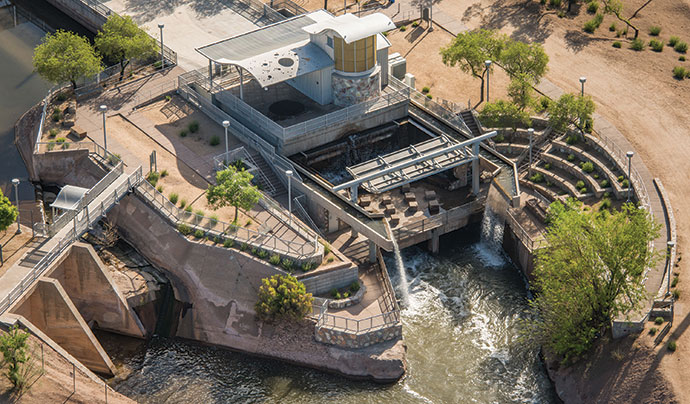Water and energy company Salt River Project has worked for more than a century to support the growth of booming metro Phoenix. Thinking a century ahead has been central to its mission.
When the community-based not-for-profit was launched in 1903, little did the founders know that their community by 2017 would become the fourth-fastest growing metro area in the United States, approaching 4.7 million people.
Then again, maybe they knew more than they let on.
That might be because they knew their goal was not to optimize return on investment for shareholders, but optimize benefits for the community, beginning with water provision. Among the water planning elements in place today:
- Unique-in-the-nation water management regulations adopted in 1980 (Groundwater Management Act)
- Securing water for at least 100 years of future demands before growth occurs (Assured Water Supply Program)
- Effective water conservation requirements for all water users from the Arizona Department of Water Resource (ADWR) Conservation Programs and SRP Water Conservation Programs
- A decrease in net water demand by focusing economic development on SRP lands with a history of water use
- Innovative, strategic partnerships that produce water resource solutions, including SRP’s partnerships with cities to provide water for city water treatment plants and SRP’s Gila River Water Storage (GRWS) partnership with the Gila River Indian Community that will make several million acre-feet of water supplies available to water users in central Arizona.
That matrix of resources gives confidence to investors such as Niagara Bottling Company, which recently located an operation in Mesa, a city with direct access to several water resources including the Central Arizona Project, Salt River Project and natural ground water.

Planning for the next 100 years, SRP is preparing for continued economic prosperity with new strategic partnerships and the renewable water supplies needed to move the Salt River Valley forward. In addition to providing electricity to approximately 1 million retail customers in a 2,900-square-mile service area that spans three Arizona counties, it manages the Salt and Verde River water and groundwater resources, including the operation of seven dams, three recharge projects, 131 miles of canals and over 1,000 miles of laterals for the efficient storage and delivery of water, and planning for future water needs by investing in new supplies.
SRP isn’t a potable water provider, so the Valley’s cities are the primary points of contact and water service providers to growing companies. But SRP is a valuable source of water resource expertise and information. “And in the event a corporate prospect has specialized water needs, SRP can provide water resource information, access to water delivery infrastructure, and additional water resources through GRWS,” says SRP Director of Water Strategy Christa McJunkin.
Conservation is key. Indeed, SRP’s leadership is a major reason the entire state can boast that its total water use since 1980 has decreased by one-third even as its population more than doubled. “Arizona uses the same amount of water today as it did in 1957, even though the population is five times larger,” McJunkin says. Residential water conservation has been SRP’s focal point, but in 2018, SRP and Valley cities embarked on a program to train city water conservation specialists in Commercial, Industrial and Institutional (CII) water audits.
“We hope to expand this program in the future,” she says, “so that we can meet both the energy and water audit needs of our corporate customers.”
Those customers are already pretty water-savvy, she says, and often have their own corporate sustainability commitment. Intel’s Ocotillo Campus is a prime example, with a water efficiency program that conserves approximately 5.2 million gallons of water each day. In 2017, Intel announced it aims to restore 100% of its global water use by 2025 through collaborative community-based projects, starting in Arizona.
“Where we are finding a growing need for innovation and education is in the data center realm,” McJunkin says. “More and more companies are finding the Valley to be a great place to locate a data center. Energy efficiency is typically the major driving factor in data center cooling system design, but in the desert, water efficiency needs to be considered as well. We have worked with a number of data centers to educate them on the options for efficient water use.”
Technology and management are as crucial as conservation. SRP’s tools include Flowtography, a method of recording stream depths using time-lapse photography and precisely located event gauges. SRP in 2017 added Snowtography, which records snow levels during the winter and also four-season monitoring of watershed health over time at strategically selected elevations between 4,000 to 8,000 feet. Runoff in 2017 was healthy, and after the driest year on record in 2018, early 2019 runoff was healthy too: SRP anticipates its six reservoirs on the Salt and Verde rivers will receive more than 1 million acre-feet from January 1 through the end of May.
Today and Tomorrow
Even with such welcome events, “We all recognize we’re looking at a drier future,” Tom Buschatzke, director of the ADWR, told the Associated Press as Arizona and six other states successfully completed a drought contingency plan (DCP).
“SRP participated extensively in the DCP negotiations and is even contributing water to the mitigation program necessary for implementation of the DCP,” says McJunkin. “SRP’s water rights and water supplies are not tied to the Colorado River and our supplies would not be harmed by a Colorado River shortage. However, we’ve long recognized that we are all in this together. SRP’s water management strategy is to find collaborative solutions that provide broad benefits regionally.”
What else might the future hold? Among other projects, SRP is working with the Arizona-Mexico Commission on a binational desalination study, a preliminary investigation to identify a range of opportunities for future development of binational desalination that provides benefits to water users in Mexico and the United States.
In other words, the region goes well beyond the Valley. So do the teamwork and vision.
“We know from our long experience that water resource solutions are seldom a solo endeavor,” McJunkin says. “Our greatest successes have come from collaboration and partnerships.’
This Investment Profile was prepared under the auspices of Salt River Project. For more information, go to www.powertogrowphx.com.

